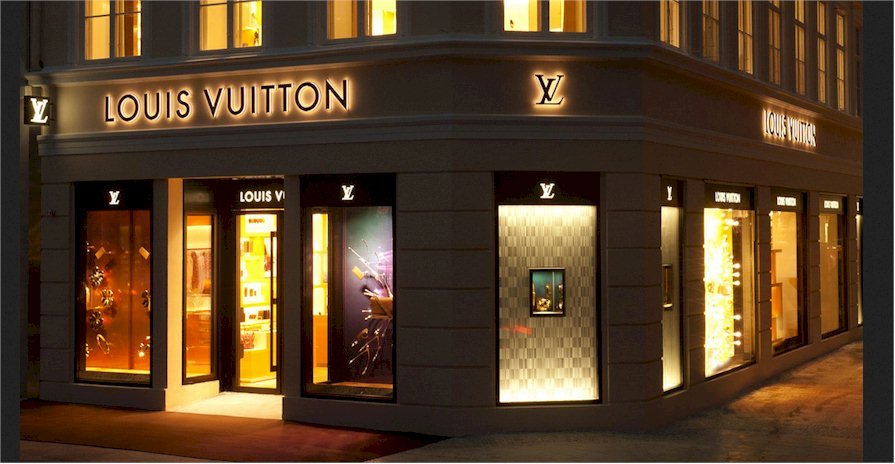This is a look at the Louis Vuitton Logo and history behind this massive brand in the fashion industry.
There aren’t many companies in the world today that can boast about being in business since the mid-1800s The world-renowned fashion brand Louis Vuitton, though – which was first founded in 1854 – is one of them. Over the more than two and half centuries that Louis Vuitton has been in operation, the brand has gone on to become one of the most famous and easily recognized fashion brands across the world. While the success that Louis Vuitton has enjoyed all of these years is certainly thanks in large part to the quality and style of their ever-expanding product line, the unique and eye-catching logo that can be found across both Louis Vuitton’s apparel and marketing efforts have certainly played an important role in the brand’s fame as well. In this article, we’ll take a look at the long and storied history of Louis Vuitton, the origins of their logo design, and how the Louis Vuitton logo has helped propel the brand to the very top of the fashion industry.
The History of Louis Vuitton

In 1854, a Frenchman named Louis Vuitton started a luggage company that he named after himself. It wasn’t until 1858, though, that Vuitton designed a style of luggage that really put the brand on the map. At the time, most of the luggage on the market were rounded-top trunks that were designed primarily to promote water runoff. Louis Vuitton, however, decided to introduce a flat top trunk that would go easier to stack and store during travel.
For several years, Louis Vuitton sold his new brand of luggage primarily at trade shows across Europe. In 1885, though, the Louis Vuitton brand opened its first store in London, England. Seven years later, in 1892, Louis Vuitton passed away, and ownership of the company was handed down to his son, Georges Vuitton.
Following the death of his father, Georges set himself on a mission to grow the Louis Vuitton brand into a worldwide company. He exhibited the company’s products at the Chicago World’s Fair in 1893 and, in 1896, launched Louis Vuitton’s signature Monogram Canvas and secured worldwide patents on it.
Before these patents were secured, counterfeiting was a big issue for Louis Vuitton. After the company began using its patented Monogram Canvas on all of its products, though, it became much less of a problem.
By 1913, Louis Vuitton had opened the Louis Vuitton Building in Paris. At the time, this store was the largest travel-goods store in the world. Georges also went on to open other Louis Vuitton stores in New York, London, Alexandria, Washington, Buenos Aires, and Bombay.
In 1936, Georges Vuitton died and passed ownership of the company to his son Gaston-Louis Vuitton. A few years later, when Germany invaded France at the peak of WWII, the Louis Vuitton brand entered a controversial period in their history. Throughout Germany’s occupation of France, Louis Vuitton partnered with the Germans in order to dramatically increase their wealth. In response to a book that was published detailing Louis Vuitton’s business relations with Nazi Germany, a spokesperson for the brand later said, “This is ancient history. The book covered a period when it was family-run and long before it became part of LVMH. We are diverse, tolerant, and all the things a modern company should be.”
At any rate, the Louis Vuitton brand survived the controversy and came out of WWII more popular than ever. Following the war, Louis Vuitton began to incorporate leather into its product line and revamped its Monogram Canvas so that it was more supple and better for use in purses, bags, and wallets. This allowed the brand to dramatically expand its product line beyond the luggage that it was primarily known for at the time.
By 1989, Louis Vuitton was operating a total of 130 stores worldwide, and in 1997, the brand introduced its first line of clothing for men and women. Since then, Louis Vuitton has gone on to become one of the most profitable fashion brands in the world. A 2010 study conducted by Millward Brown listed Louis Vuitton as the world’s 19th most valuable brand and estimated its worth at a little over $19 billion.
 Today, Louis Vuitton still has the unfortunate title of being one of the most counterfeited brands in the world as well. In 2004, Louis Vuitton fakes accounted for 18% of counterfeit accessories that were seized by the European Union.
Today, Louis Vuitton still has the unfortunate title of being one of the most counterfeited brands in the world as well. In 2004, Louis Vuitton fakes accounted for 18% of counterfeit accessories that were seized by the European Union.
In this fight against counterfeit products that Louis Vuitton is still caught up in, the Louis Vuitton logo has played a central role. Its design and the Monogram Canvas that it is found on were originally meant to prevent the production of counterfeit logos. Today, though, the status symbol that the Louis Vuitton logo has become is now one of the central reasons why so many fake Louis Vuitton products exist.
Nevertheless, having a logo so highly esteemed that it is copied by counterfeiters is a good problem to have. As a brand built around name recognition and status, the Louis Vuitton logo has been central to the company’s success. Interestingly enough, the logo that Louis Vuitton initially adopted well over a century ago is still the exact same design that the brand employs to this day.
The History of the Louis Vuitton Logo

When Georges Vuitton took over the Louis Vuitton brand following his father’s passing in 1892, he wanted to create a logo for the company that could be used on the new canvas he had designed and patented in order to set Louis Vuitton luggage apart from the numerous companies that were trying to copy their style.
The logo that he created is a hand-drawn typeface of the letter V overlapping the letter L and was said to have been loosely inspired by roman fonts. In the decades that have passed since this first logo design was unveiled, the Louis Vuitton logo has changed very little at all. Not many brands can say that they have not changed from their original logo, much less brands that have been in existence for over a century. The only alteration that the Louis Vuitton logo has undergone since 1892, though, was the removal of the brand’s name underneath the monogram. In 1997, designer Mark Jacobs decided to begin using the LV monogram alone across Louis Vuitton’s marketing efforts. Aside from this subtle alteration, though, the Louis Vuitton logo that you see today is the same as the one that was first designed for the company over a hundred years ago.
Design Elements of the Louis Vuitton Logo
The Louis Vuitton logo is a minimalistic design that doesn’t rely on fancy or elaborate design elements to get its message across. If anything, the unchanging nature of the Louis Vuitton logo’s design is what sets it apart the most from other logos in the fashion industry.
The Louis Vuitton logo is a status symbol that brings incredible value to the products it is placed on, and it is a status symbol that has not once been revised over an era where almost everything about the rest of the world has changed dramatically. Today, customers who appreciate Louis Vuitton’s history see the brand’s iconic logo as a testament to its relevance and staying power. It’s a classic, unchanging design that speaks to Louis Vuitton’s long and eventful story, and it’s one that proves you don’t need an over-the-top or dramatic logo in order to create a design that will become recognizable all over the world.
The popularity of the Louis Vuitton Logo
 Like most high-end fashion brands, Louis Vuitton incorporates its logo across its line of products, and it is this logo and the status associated with it that creates demand for Louis Vuitton products. It’s also this logo that Louis Vuitton has used as the central design element across their various marketing efforts.
Like most high-end fashion brands, Louis Vuitton incorporates its logo across its line of products, and it is this logo and the status associated with it that creates demand for Louis Vuitton products. It’s also this logo that Louis Vuitton has used as the central design element across their various marketing efforts.
Originally, the Louis Vuitton logo was designed in order to help protect the authenticity of the brand’s products, and this is a role that the logo still plays today. When checking whether or not a Louis Vuitton product might be counterfeited, inspecting the design of the Louis Vuitton logo on the product is one of the first ways to determine if it is genuine.
If you are looking to create a simple yet recognizable logo design for your own brand, the Louis Vuitton logo is a great place to draw inspiration. Its simple yet unique design has served the brand since 1892, making it one of the most long-lasting logo designs that still enjoys popularity to this day. While a lot of work certainly went into crafting the Louis Vuitton brand image so that its logo would become the status symbol that it now is, an appealing design for the logo was an essential starting point for the company’s goals. Anyone hoping to create a brand that reaches the lofty status that Louis Vuitton has acquired would do well to consider just how much value an attractive and elegant logo design can offer.
———-
LogoMyWay offers custom clothing logos for your brand and also gives you the ability to create your own logo using our clothing brand logo maker. You can browse thousands of logos and create your logo in less than 10 minutes. Try it free.







